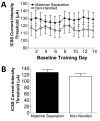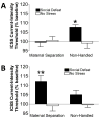Neonatal maternal separation exacerbates the reward-enhancing effect of acute amphetamine administration and the anhedonic effect of repeated social defeat in adult rats
- PMID: 20691770
- PMCID: PMC2949486
- DOI: 10.1016/j.neuroscience.2010.08.002
Neonatal maternal separation exacerbates the reward-enhancing effect of acute amphetamine administration and the anhedonic effect of repeated social defeat in adult rats
Abstract
Early life adversity or parental neglect is linked to the development of a number of psychiatric illnesses, including major depression and substance use disorder. These two disorders are often comorbid and characterized by anhedonia, defined as the reduced ability to experience pleasure or reward. The aim of the present study was to determine the effects of neonatal maternal separation in Long Evans rats, a model of early life stress, on anhedonia under baseline conditions and in response to drug and stress exposure during adulthood. Three hours of daily maternal separation from postnatal day 1 to 14 led to marked decreases in arched-back nursing, licking, and grooming of pups by their dams. In adulthood, brain reward function was assessed using intracranial self-stimulation of the lateral hypothalamus. Lowered current thresholds derived from this procedure are interpreted as reward-enhancing effects, whereas elevations in thresholds are an operational measure of anhedonia. Maternally separated rats did not exhibit anhedonia under baseline conditions compared with non-handled controls but exhibited a greater reward-enhancing effect of acute amphetamine administration. Acute social defeat produced anhedonia in non-handled controls, but not in maternally separated rats. Conversely, control rats habituated to 7 days of repeated social defeat, whereas maternally separated rats developed an increased anhedonic response to the repeated stressor. One week after termination of stress exposure, maternally separated rats still exhibited an increased reward-enhancing effect of acute amphetamine administration compared with non-handled controls, regardless of prior social defeat experience. These data indicate that early life stress increases the reward-enhancing properties of amphetamine, protects against the anhedonic effects of acute stress exposure, and exacerbates the anhedonic response to repeated stress. Thus, early life stress may increase an individual's vulnerability to depressive or addictive disorders when confronted with stress or drug challenge in adulthood.
Copyright © 2010 IBRO. Published by Elsevier Ltd. All rights reserved.
Figures






Similar articles
-
Enduring deficits in brain reward function after chronic social defeat in rats: susceptibility, resilience, and antidepressant response.Biol Psychiatry. 2014 Oct 1;76(7):542-9. doi: 10.1016/j.biopsych.2014.01.013. Epub 2014 Jan 31. Biol Psychiatry. 2014. PMID: 24576687 Free PMC article.
-
Sex, but not repeated maternal separation during the first postnatal week, influences novel object exploration and amphetamine sensitivity.Dev Psychobiol. 2011 Mar;53(2):132-40. doi: 10.1002/dev.20499. Epub 2010 Sep 30. Dev Psychobiol. 2011. PMID: 20886535
-
Influence of early postnatal rearing conditions on mesocorticolimbic dopamine and behavioural responses to psychostimulants and stressors in adult rats.Eur J Neurosci. 2004 Apr;19(7):1863-74. doi: 10.1111/j.1460-9568.2004.03286.x. Eur J Neurosci. 2004. PMID: 15078560
-
Peculiar response of adolescent mice to acute and chronic stress and to amphetamine: evidence of sex differences.Behav Brain Res. 2002 Mar 10;130(1-2):117-25. doi: 10.1016/s0166-4328(01)00420-x. Behav Brain Res. 2002. PMID: 11864727 Review.
-
Gene expression in aminergic and peptidergic cells during aggression and defeat: relevance to violence, depression and drug abuse.Behav Genet. 2011 Nov;41(6):787-802. doi: 10.1007/s10519-011-9462-5. Epub 2011 Mar 17. Behav Genet. 2011. PMID: 21416141 Free PMC article. Review.
Cited by
-
Early Caregiving and Human Biobehavioral Development: A Comparative Physiology Approach.Curr Opin Behav Sci. 2016 Feb;7:82-90. doi: 10.1016/j.cobeha.2015.12.002. Curr Opin Behav Sci. 2016. PMID: 26753173 Free PMC article.
-
Maternal separation increases methamphetamine-induced damage in the striatum in male, but not female rats.Behav Brain Res. 2015 Dec 15;295:3-8. doi: 10.1016/j.bbr.2014.12.008. Epub 2014 Dec 20. Behav Brain Res. 2015. PMID: 25535855 Free PMC article.
-
Neurodevelopmental origins of substance use disorders: Evidence from animal models of early-life adversity and addiction.Eur J Neurosci. 2022 May;55(9-10):2170-2195. doi: 10.1111/ejn.15223. Epub 2021 Apr 25. Eur J Neurosci. 2022. PMID: 33825217 Free PMC article. Review.
-
Developmental stress elicits preference for methamphetamine in the spontaneously hypertensive rat model of attention-deficit/hyperactivity disorder.Behav Brain Funct. 2016 Jun 17;12(1):18. doi: 10.1186/s12993-016-0102-3. Behav Brain Funct. 2016. PMID: 27317355 Free PMC article.
-
The Developmental Origins of Opioid Use Disorder and Its Comorbidities.Front Hum Neurosci. 2021 Feb 11;15:601905. doi: 10.3389/fnhum.2021.601905. eCollection 2021. Front Hum Neurosci. 2021. PMID: 33643011 Free PMC article. Review.
References
-
- Antelman SM, Eichler AJ, Black CA, Kocan D. Interchangeability of stress and amphetamine in sensitization. Science. 1980;207 (4428):329–31. - PubMed
-
- Arellano CM. Child maltreatment and substance use: a review of the literature. Subst Use Misuse. 1996;31 (7):927–35. - PubMed
-
- Association AP. Diagnostic and Statistical Manual of Mental Disorders IV. Washington D.C.: American Psychiatric Press; 1994.
-
- Bifulco A, Brown GW, Adler Z. Early sexual abuse and clinical depression in adult life. Br J Psychiatry. 1991;159:115–22. - PubMed
-
- Brake WG, Zhang TY, Diorio J, Meaney MJ, Gratton A. Influence of early postnatal rearing conditions on mesocorticolimbic dopamine and behavioural responses to psychostimulants and stressors in adult rats. Eur J Neurosci. 2004;19 (7):1863–74. - PubMed
Publication types
MeSH terms
Substances
Grants and funding
LinkOut - more resources
Full Text Sources
Medical

